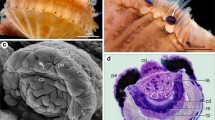Summary
Shape and fine structure of the aesthetes located in the uppermost calcareous layer of the shell plates (tegmentum) ofChiton marmoratus L. were demonstrated. Special interest was given to the intrapigmental eye which is laterally inserted in the aesthete body. It consists of a calcareous lens derived from the tegmentum, sensory cells with long microvilli at their distal end forming a rhabdomere, and a pigment cup. The shell eye of the Placophora was compared with the eyes of other invertebrates. We suppose that the intrapigmental eye is derived from a primitive photoreceptor like that we have described of the aesthete body below the macraesthete ofLepidochitona cinerea (L.). The macraesthete probably has no photoreceptor function.
Zusammenfassung
Die in der obersten Schalenschicht (Tegmentum) verteilten Ästheten vonChiton marmoratus L. wurden in Gestalt und Feinstruktur dargestellt. Dabei wurde besonders das intrapigmentäre Schalenauge berücksichtigt. Dieses sitzt den Ästheten seitlich an. Es besteht aus einer kalkigen Linse, die aus dem Tegmentum hervorgegangen ist, den Sinneszellen, deren lange distale Mikrovilli ein Rhabdomer bilden, und einem Pigmentbecher. Ein Vergleich der intrapigmentären Schalenaugen mit den Photoreceptoren von anderen Invertebraten wurde durchgeführt. Das intrapigmentäre Schalenauge leitet sich vermutlich von einem primitiven Photoreceptor ab, wie wir ihn vom Ästhetenkörper unterhalb des Makrästheten beiLepidochitona cinerea (L.) beschreiben. Der Makrästhet selbst hat wahrscheinlich keine photoreceptorische Funktion.
Similar content being viewed by others
Literatur
Bauer, K.: A behavioral light response in the chitonStenoplax heathiana. The Veliger18, 74–78 (1975)
Bedini, C., Ferrero, E., Lanfranchi, A.: Fine structural changes induced by circadian light-dark cycles in photoreceptors of Dalyelliidae (Turbellaria: Rhabdocoela). J. Ultrastruct. Res.58, 66–77 (1977)
Blumrich, J.: Das Integument der Chitonen. Z. Wiss. Zool.52, 404–476 (1891)
Boyle, P.R.: Fine structure of the eyes ofOnithochiton neglectus (Mollusca: Polyplacophora). Z. Zellforsch.102, 313–332 (1969)
Boyle, P.R.: The aesthetes of chitons. I. Role in the light response of whole animals. Mar. Behav. Physiol.1, 171–184 (1972)
Boyle, P.R.: The aesthetes of chitons. II. Fine structure inLepidochitona cinereus (L.). Cell Tiss. Res.153, 383–398 (1974)
Brandenburger, J.L., Eakin, R.M.: Pathway of incorporation of vitamin A3H2 into photoreceptors of a snail,Helix aspersa. Vision Res.10, 639–653 (1970)
Carpenter, K.S., Morita, M., Best, J.B.: Ultrastructure of the photoreceptor of the planarianDugesia dorotocephala. II. Changes induced by darkness and light. Cytobiol.8, No. 2, 320–338 (1974)
Crozier, W.J.: Note on the photic sensivity of the chitons. Am. Nat.54, 376–380 (1921)
Eakin, R.M.: Structure of invertebrate photoreceptors. In: Photochemistry of vision. Handbook of sensory physiology, Vol. VII/1 (H.J.A. Dartnall, ed.), pp. 625–684. Berlin-Heidelberg-New York: Springer 1972
Eakin, R.M., Brandenburger, J.L.: Differentiation in the eye of a pulmonate snail,Helix aspersa. J. Ultrastruct. Res.8, 391–421 (1967)
Eakin, R.M., Brandenburger, J.L.: Light induced ultrastructural changes in eyes of a pulmonate snail,Helix aspersa. J. Ultrastruct. Res.21, 164 (1968)
Evans, F.G.: An analysis of the behaviour ofLepidochitona cinereus in response to certain physical features of the environment. J. Anim. Ecol.20, 1–10 (1951)
Fischer-Piette, E., Franc, A.: Classe des polyplacophores. In: Traité de zoologie. Vol. 5 (P.-P. Grassé, ed.), pp. 1701–1785. Paris: Masson 1960
Haas, W.: Untersuchungen über die Mikro- und Ultrastruktur der Polyplacophorenschale. Biomin.6, 1–52 (1972)
Haas, W.: Observations of the shell and mantle of the Placophora. In: The machanisms of mineralization in invertebrates and plants (N. Watabe, K.M. Wilbur, eds.). The Belle W. Baruch Library in Marine Sciences5, 389–402 (1977)
Haas, W., Kriesten, K.: Studien über das Mantelepithel vonLepidochitona cinerea (L.) (Placophora). Biomin.7, 100–109 (1974)
Haas, W., Kriesten, K.: Studien über das Perinotum-Epithel und die Bildung der Kalkstacheln vonLepidochitona cinerea (L.) (Placophora). Biomin.8, 92–107 (1975)
Heath, H.: The development of Ischnochiton. Zool. Jahrb., Abt. Anat. Ontog.12, 567–656 (1899)
Hermans, C.O., Eakin, R.M.: Fine structure of the cerebral ocelli of a Sipunculid,Phascolosoma agassizii. Z. Zellforsch.100, 325–339 (1969)
Hoffmann, H.: Amphineura und Scaphopoda. In: Klasse und Ordnungen, Bd. 3 (H.G. Bronn, Hrsg.). Leipzig: Akadem. Verlagsges. 1930
Hyman, L.H.: The invertebrates, Vol. 6, Mollusca I. New York: McGraw-Hill 1967
Knorre, H. v.: Die Schale und die Rückensinnesorgane vonTrachydermon (Chiton) cinereus L. und die ceylonischen Chitonen der Sammlung Plate. Jena. Z. Med. Naturw.61, 469–632 (1925)
Nowikoff, M.: Über die Rückensinnesorgane der Placophoren nebst einigen Bemerkungen über die Schale derselben. Z. Wiss. Zool.88, 154–186 (1907)
Nowikoff, M.: Über die intrapigmentären Augen der Placophoren. Z. Wiss. Zool.93, 668–680 (1909)
Omelich, P.: The behavioural role and the structure of the aesthetes of chitons. Veliger10, 77–82 (1967)
Spurr, A. R.: A low-vescosity epoxy resin embedding medium for electron microskopy. J. Ultrastruct. Res.26, 31–43 (1969)
Yamamoto, T., Tasaki, K., Sugawara, Y., Tonosaki, A.: Fine structure of the octopus retina. J. Cell Biol.25, 354–395 (1965)
Author information
Authors and Affiliations
Additional information
Die Arbeit entstand als Nebenprodukt unserer in der Forschergruppe Biomineralisation von der Deutschen Forschungsgemeinschaft geförderten Arbeiten. Wir danken den Herren Dr. K. Werding und Dr. F. Köster vom Institute Columbo-Aleman de Investigationes Cientificas ‚Punto Betin‘ in Santa Marta, Kolumbien, für ihre wertvolle Unterstützung bei der Aufsammlung des Materials. Herr Prof. Dr. H.K. Erben, Bonn, überließ uns freundlicherweise von ihm in Mexiko gesammelte Exemplare vonChiton albolineatus Sowerby. Herrn Priv. Doz. Dr. G. Flajs, Bonn, sind wir für die Herstellung einiger schwieriger REM-Aufnahmen verpflichtet
Rights and permissions
About this article
Cite this article
Haas, W., Kriesten, K. Die Ästheten mit intrapigmentärem Schalenauge vonChiton marmoratus L. (Mollusca, Placophora). Zoomorphologie 90, 253–268 (1978). https://doi.org/10.1007/BF01007694
Received:
Issue Date:
DOI: https://doi.org/10.1007/BF01007694




